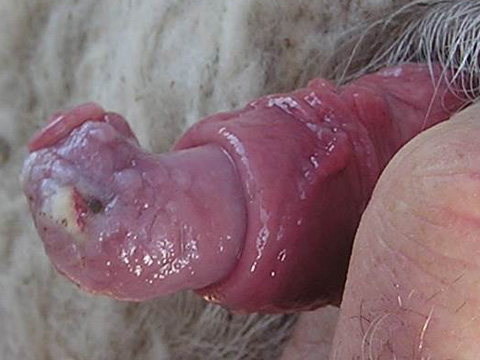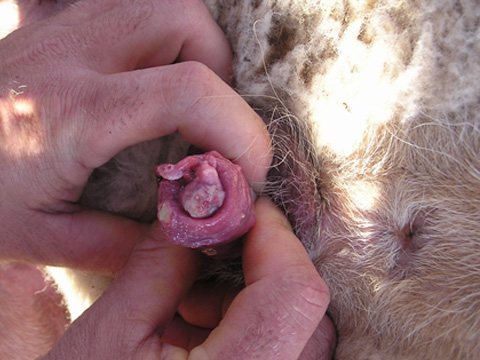



About Dorpers
Pizzle Disease
Protocol
PIZZLE DISEASE Protocol as discussed on 29 th September 2003 at a workshop attended by the Council of the Dorper Sheep Breeders Society, Provincial Veterinary Services and Private Veterinaries
Acknowledgement and thanks to the hereunder mentioned Veterinaries for compiling this
Protocol and all persons who attended the Workshop and contributed to the project:
Dr J A van Rooyen - Steynsburg
Dr R Larson - Graaff Reinet
Dr J Pienaar - Beaufort West
Dr G van Aardt - Kroonstad
Please report all cases to the society or to your veterinary
This is crucial in order to establish a record of progress and to endeavour to assist flocks with problems to eradicate the disease. We will appreciate input and reports from farmers and veterinaries when you try this protocol.
We aim to eradicate this disease and we need the assistance of every person involved in the industry.
A flock can be classified as follows
- Clean with no clinical cases or type 4 scars
- Stable infected flock: Infected but few clinical cases. New additions to the flock becomes clinical cases
- Unstable infected flock: Infected with active clinical cases.
1. Clean flock
- Only purchase “clean” rams
- Apply trial-mating with 10 young ewes and keep separated for 30 days. Examine rams before adding to rest of ram flock.
Apply strict biological security measures
- Keep boundary fences in good repair and avoid contact with neighbouring, possibly infected, flocks.
- Establish a quarantine station /section where additions can be observed for 30 days before incorporation with the flock. Apply strict tick and fly control.
- Prevent mechanical contamination by handlers, shoes, feet, shearers, AI technicians, (artificial vagina sheaths) from infected flocks.
In case of outbreak
- Drastic action such as isolation, slaughter, selling or
- handle as unstable infected flock
2. Stable infected flock
Rectify nutritional deficiencies, parasite problems and stress factors. Especially the administration of vitamin A, D, E and Zinc before mating.
Local area deficiencies must also be attended to.
2.1 Apply precautionary anti microbic treatment
- Half a tube mastitis remedy in each sheath before mating. This may be repeated or
- Injecting with long acting Tetracycline Or Penicillin before mating. May be repeated or
- Injection plus local treatment with Acriflavine/Glycerin or tempered Iodine (Povodine) before mating
Mark all rams after examination
Green tags
No scars or history of pizzle disease.
Yellow tags
Only one attack of pizzle disease.
Red tags
More than one attack of pizzle disease.
3. Unstable infected flock
- Rectify nutritional deficiencies, parasite problems, and stress factors. Especially administration of Vit A, D, E and Zink before mating. Local area deficiencies must also be attended to.
- Treat acute cases. In all cases the administration of Vit A, E and Zink as well as Ammonium chloride can possibly expedite the healing process.
- Type 1 scar: Inject with an anti- microbic substance with proven effectiveness against Mycoplasm spp. Advocin, Baytril, Tylan
-
Type 2 scar: Treat and return to flock when healed. Inject with long acting tetracycline or penicillin
Optional: Repeat with further 2 injections – in other words 8 days anti biotic coverage
Optional: Sheath treatment with acriflavine/glycerine or tempered Iodine (Povodine)
Handle penis and sheath as little as possible. Disinfect hands and apparatus between cases. - Type 3 scar can be treated as type 2 scar but will usually have to be culled.
Mark all rams after examination
Green tags
No scars or history of pizzle disease.
Yellow tags
Only one attack of pizzle disease.
Red tags
More than one attack of pizzle disease.
Classification of scars in rams
| Scar on penis | Type 1 | Type 2 | Type 3 | Type 4 |
| Inflammation (red, swollen, sore) | Yes | |||
| Exudate (Bloody, purulent Excretion) | Yes | Yes | ||
| Blister | Yes | |||
| Ulcer (Raw wound) | Yes | Yes | ||
| Paraphimose Penis protrudes | Yes | |||
| Connective tissue scar | Yes |
Control programme
Phase 1 (5 years)
Introduce a fixed mating period
34 days ( 2 cycles) 42 days, or 51 days ( 3 cycles)
Introduce strict biological security
- Keep boundary fences in good repair and avoid contact with infected flocks
- Establish a quarantine station/ section where additions can be observed for 30 days before incorporation with the rest of the flock. Apply strict tick and fly control.
- Prevention of mechanical contamination by handlers, feet, shoes, shearers, AI technicians (artificial vagina sheaths) from infected flocks.
No mating in biological security zone
No mating in biological security zone after mating period until minimum of 8 month cycle has been completed. A farming operation can install more than one section without contact between the different sections.
Dry ewes
All dry ewes must be removed after sonar–scan and/or on the last day of the lambing season.
New rams
Purchase only “clean” rams. Apply trial mating on 10 young ewes and keep isolated for 30 days. Examine rams before incorporation with rest of flock.
Records
Phase 2
- First certificate of compliance after 3 repeated clean mating seasons and possibly future blood test to identify infection.
- Annual or bi-annual certificate of maintenance.
- Acknowledgement and advantages for certified flocks.
Mark all rams after examination
Green tags
No scars or history of pizzle disease.
Yellow tags
Only one attack of pizzle disease.
Red tags
More than one attack of pizzle disease.









